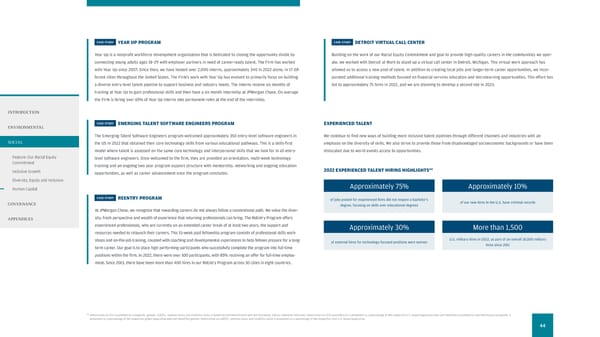CASE STUDY YEAR UP PROGRAM CASE STUDY DETROIT VIRTUAL CALL CENTER Year Up is a nonproft workforce development organization that is dedicated to closing the opportunity divide by Building on the work of our Racial Equity Commitment and goal to provide high-quality careers in the communities we oper- connecting young adults ages 18–29 with employer partners in need of career-ready talent. The Firm has worked ate, we worked with Detroit at Work to stand up a virtual call center in Detroit, Michigan. This virtual work approach has with Year Up since 2007. Since then, we have hosted over 2,000 interns, approximately 340 in 2022 alone, in 17 dif- allowed us to access a new pool of talent. In addition to creating local jobs and longer-term career opportunities, we incor- ferent cities throughout the United States. The Firm’s work with Year Up has evolved to primarily focus on building porated additional training methods focused on fnancial services education and microlearning opportunities. This efort has a diverse entry-level talent pipeline to support business and industry needs. The interns receive six months of led to approximately 75 hires in 2022, and we are planning to develop a second site in 2023. training at Year Up to gain professional skills and then have a six month internship at JPMorgan Chase. On average the Firm is hiring over 65% of Year Up interns into permanent roles at the end of the internship. INTRODUCTION CASE STUDY EMERGING TALENT SOFTWARE ENGINEERS PROGRAM EXPERIENCED TALENT ENVIRONMENTAL The Emerging Talent Software Engineers program welcomed approximately 350 entry-level software engineers in We continue to fnd new ways of building more inclusive talent pipelines through diferent channels and industries with an SOCIAL the US in 2022 that obtained their core technology skills from various educational pathways. This is a skills-frst emphasis on the diversity of skills. We also strive to provide those from disadvantaged socioeconomic backgrounds or have been model where talent is assessed on the same core technology and interpersonal skills that we look for in all entry- dislocated due to world events access to opportunities. Feature: Our Racial Equity level software engineers. Once welcomed to the frm, they are provided an orientation, multi-week technology Commitment training and an ongoing two year program support structure with mentorship, networking and ongoing education Inclusive Growth 2022 EXPERIENCED TALENT HIRING HIGHLIGHTS44 opportunities, as well as career advancement once the program concludes. Diversity, Equity and Inclusion Human Capital Approximately 75% Approximately 10% CASE STUDY REENTRY PROGRAM of jobs posted for experienced hires did not require a bachelor’s GOVERNANCE degree, focusing on skills over educational degrees of our new hires in the U.S. have criminal records At JPMorgan Chase, we recognize that rewarding careers do not always follow a conventional path. We value the diver- APPENDICES sity, fresh perspective and wealth of experience that returning professionals can bring. The ReEntry Program ofers experienced professionals, who are currently on an extended career break of at least two years, the support and Approximately 30% More than 1,500 resources needed to relaunch their careers. This 15-week paid fellowship program consists of professional skills work- shops and on-the-job training, coupled with coaching and developmental experiences to help fellows prepare for a long- of external hires for technology-focused positions were women U.S. military hires in 2022, as part of an overall 18,000 military term career. Our goal is to place high performing participants who successfully complete the program into full-time hires since 2011 positions within the frm. In 2022, there were over 100 participants, with 85% receiving an ofer for full-time employ- ment. Since 2013, there have been more than 400 hires in our ReEntry Program across 30 cities in eight countries. 44 Information on EEO race/ethnicity categories, gender, LGBTQ+, veteran status and disability status is based on self-identifcation and self-disclosure. Unless otherwise indicated, information on EEO race/ethnicity is presented as a percentage of the respective U.S.-based population who self-identifed race/ethnicity and information on gender is presented as a percentage of the respective global population who self-identifed gender; information on LGBTQ+, veteran status and disability status is presented as a percentage of the respective total U.S.-based population. 44
 2022 Environmental Social Governance Report Page 45 Page 47
2022 Environmental Social Governance Report Page 45 Page 47